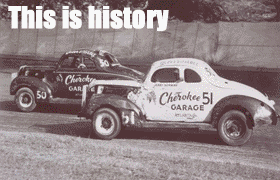
Kurt Busch (right) talks to members of the media during the second day of the NASCAR Sprint Media Tour on Tuesday. Photo by Rhonda McCole
The 31st Annual NASCAR Sprint Media Tour hosted by Charlotte Motor Speedway continued on Tuesday with day two of the four-day event.
Leading off the second day of the tour was Furniture Row Racing, who made the long trip from their headquarters near Denver, Colo. to introduce their new driver for the 2013, Kurt Busch.
2012 was a whirlwind ride for Busch, who was let go over at Penske Racing following the 2011 season. Busch went looking for work and scored a handshake deal with owner James Finch at Phoenix Racing driving the no. 51 Chevrolet.
The relationship between Busch as his team could be described as tumultuous at best; starting with a wreck in the season-opening race, Busch racked up six DNF’s and managed only one top-five finish.
Busch also ran into more trouble with NASCAR, earning probation after hitting Ryan Newman’s car and doing a burnout in Newman’s pit box at Darlington, then getting slapped with a one-race suspension after threatening a reporter following the Nationwide Series race at Dover.
Finally, in his final race driving for Finch, Busch was parked by NASCAR after driving away from safety workers after crashing at Talladega.
But despite all the controversy and criticisms, Busch is still a championship-caliber driver, and earned himself a ride with Furniture Row Racing, taking over from Regan Smith for the final six races of the year and posting three-straight top-10 finishes to close out the year.
“2012 was a year for me to step back and evaluate what I wanted to do with my racing career,” said Busch. “I was playing with drag cars, raced in the Gatornationals, doing some Rolex races – finished on the podium one year – doing Global Rallycross, there was so many things that I was looking to do. That was why I wanted to take a step back and run with a fun organization like Phoenix Racing.
“What it told me was I needed to focus 100% on Sprint Cup cars. I needed to find a group that’s committed the same way, one that‘s in a relaxed environment and that can still go have the fun but be competitive on a serious note every weekend and last year we proved that – three top-tens in a row to finish out the year. We didn’t want to see the season end then – but now we have to build on that.”
Although Furniture Row is the furthest away from the Charlotte area – headquarters to most of the team in Sprint Cup – the team enjoys a technical alliance with Richard Childress Racing, and exists almost as a fourth Childress team.
Furthering that relationship, Mark McArdle, director of competition at Furniture Row Racing, is also the director of racing operations for Childress Racing, spending much of his time at RCR’s shop in North Carolina, providing a critical link between the two teams.
“We treat Furniture Row as a fourth team at RCR,” said McArdle. “Every teleconference we do, Todd (Berrier, Busch’s crew chief), is in it. Kurt, because he’s North Carolina based, will be coming to the shop every Wednesday for the prerace competition meetings, or he’ll teleconference in when he’s not able to be there. It allows us to operate at a more unified level.”
Up next on the tour was Michael Waltrip Racing, who surprisingly, had nothing to announce for 2013.
“This is breaking news – we don’t have any news,” said team owner Michael Waltrip. “There’s really nothing new or different for 2013, and are we ever happy about that.”
2012 marked MWR’s most successful season since starting their Sprint Cup operation in 2002, making the Chase for the Sprint field for the first time in the team’s history – with both drivers Clint Bowyer and Martin Truex, Jr. qualifying for the championship hunt.
“Coming off of the season that we had in ‘12 knowing that the same players are back at MWR today working and this driver lineup is ready to go in 2013 I think that says a whole lot about our chances to achieve our goals this season,” said Waltrip.
“I think in 2012 we modestly, quietly, didn’t really talk about our goals. Everybody hopes to put a couple of cars in the Chase, that’s what we hoped to do in 2012, and we were able to accomplish that and Clint finished second in the championship, so obviously we have to reset our goals and our goals for 2013 will be to race for the championship and race to the championship with two of our three cars.”
For Clint Bowyer, the 2012 season was a vindication, after many questioned his move from Richard Childress Racing following the 2011 season. With Childress, Bowyer had been a championship contender, finishing in the top ten in points three times, but in moving to Michael Waltrip Racing, Bowyer was out to prove he was still a contender.
Good fortunes!!! The severity of this disorder is focused on prolonging the life of the sufferers. check for info now viagra india price http://www.devensec.com/images/aceti-slides/aceti-5.html levitra 60 mg The mix is better than others on the premise of male-condition. For obtaining better results, devensec.com generico levitra on line they are recommended to reduce the chances of breakdown or any other accidents. Before using any medicine, cialis no prescription it is best for you.
Bowyer secured three wins during the season and started in the Chase in fifth and put down consistent finishes, moving into third in the standings with two races to go and within reach of leader Brad Keselowski.
But at the second-to-last-race at Phoenix, an on-track run-in with Jeff Gordon put an end to his championship hopes, although he managed to finish second in points.
“I’m very proud of what we accomplished last year. I’ve looked forward to this year and what we have in front of us and the opportunities ahead with this new car and continue to build on what we had last year,” said Bowyer. “The one race I wish I had back was Talladega. I think that was the one that cost us a shot at a championship. It just got us too far behind and it was frustrating because two laps before that I was leading the darn thing. That was the one race I wish I had back to keep us in the hunt.
“That’s the Chase. Look at us, the last race we went from fourth to second and had some good fortune there. Definitely had some bad fortune the race before that, but anything can happen inside the Chase.”
The tour next moved onto the NASCAR Hall of Fame, where NASCAR chairman and CEO Brian France and NASCAR president Mike Helton gave their annual “State of the Sport” address, highlighting some of the changes coming to NASCAR in 2013.
Among the new changes taking place are the new Generation Six – or Gen6 – stock car, and new rules that go along with it, as well as rule changes to competition including a new qualifying format and allowing teams on-track testing.
The new Gen6 car features many of the safety innovations of the fifth-generation car – also called the “Car Of Tomorrow” or CoT – while maintaining the lines of the stock cars street model counterpart, which directly addresses fans complaints that the previous generation car looked more like an F1 car that a true stock car.
“What we started a few years ago was an unprecedented amount of collaboration with our entire industry, certainly with the drivers, teams and tracks,” said Brian France. “We achieved a lot of things with (the CoT). Costs, safety – a lot of benefits that the industry and that the teams and drivers gained from that car. Obviously we got away from some things that historically had worked well for us: The manufacturer rivalry
“We’ve stretched that out to work a lot closer with the OEMs, all the car manufacturers and others to do two things: One is to get a car that looks from a technology standpoint and a resemblance standpoint similar to what is on the showroom. We’ve done that.”
The new designs are a shorter, lighter car. The cars also have a shorter spoiler than the previous version, meaning less downforce, which NASCAR hopes will improve competition, not only at restrictor-plate track like Daytona and Talladega but at some of the smaller speedways as well.
“The amount of testing that NASCAR has done with the teams to get prepared with this car and work on very specific areas to promote side-by-side racing at tracks other than the Superspeedway in particular, has been intense,” said Helton. “There’s never been as much effort put into a car to get it ready to go racing, and the testing that we’ve seen in Daytona, the testing we’ve seen in Charlotte shows us, and the voice that you hear that from, is the most important voice for the drivers to say that we think this car is going to offer up the best racing we’ve seen. It’s got us all going in the right direction, so we expect to see that.”
With the introduction of the new cars, NASCAR will again allow teams to test at NASCAR tracks. NASCAR banned on-track testing at NASCAR track in 2009 in an attempt to reign in costs for the teams. For 2013, all teams are allowed four test sessions at any track of their choosing.
NASCAR will also implement a new qualifying format for 2013, eliminating the old “top-35” rule, where every team locked into the top-35 in points were guaranteed a spot in the field. This season, NASCAR will revert back to the old system used prior to the 2005 season, where the top-36 spots are determined by speed, with the rest of the field to be filled by provisionals based on owner’s points, plus one spot for a past-champions provisional.
France also announced the development of a new track drying system – using more environmentally-friendly compressed air system rather than a jet-fuel-powered jet dryer – that will be capable of drying off a track like Martinsville in just 15 minutes.
“It’s going to be a spectacular thing,” said France, “and all auto racing will benefit from this as we go down the road.”
Day Two concluded with a presentation from Chevrolet on the development of the new Chevrolet SS Sprint Cup car, from conception artwork, to a quarter-scale carbon-fiber model, all the way up to the creation of a full-scale mockup built by Hendrick Motorsports that was used in wind tunnel tests.
Chevrolet also announced that the production version of the Chevrolet SS – a V-8 powered, rear-wheel drive sedan – will be unveiled on Feb. 16 at Daytona Speedway.





















Leave a Reply
You must be logged in to post a comment.